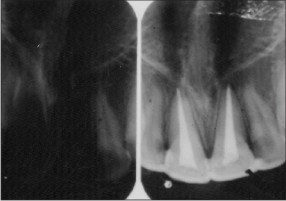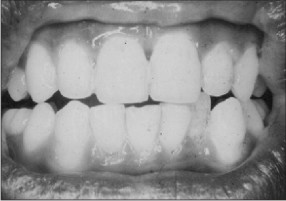|
|
|
| Delayed Replantation Of Avulsed Teeth - A Case Report |
B.S. Keshava Prasad 1 , Praveen P 2
1 Professor, Department of Conservative Dentistry and Endodontics - D A Pandu Memorial R V Dental College, CA 37, 24th Main, 1st Phase J P Nagar, Bangalore 560 078.India
2 Professor, Dept of Pediatric and Preventive Dentistry - D A Pandu Memorial R V Dental College, CA 37, 24th Main, 1st Phase J P Nagar, Bangalore 560 078.India
|
| Address For Correspondence |
Dr. B.S. Keshava Prasad
M.D.S Professor, Department of Conservative
Dentistry and Endodontics, D A Pandu Memorial
R V Dental College CA 37, 24th Main, 1st Phase
J P Nagar, Bangalore-560 078
India, Phone : 9448505151, 080-22445754
Fax:08026658411, E-mail:keshavprasad72@gmail.com |
| Abstract |
| Management of Avulsed teeth often presents a challenge to the clinician. Avulsed teeth need to be replanted at the earliest in order to restore esthetic appearance and occlusal function. However, the long term survival of replanted avulsed teeth is low due to ankylosis and root resorption. This article describes the delayed replantation of a avulsed maxillary central incisors that had an extraoral dry time of 24 hours. Tooth No. 11 showed replacement resorption at the end of 9 months indicating poor, long term prognosis. However, the function and esthetics were satisfactorily maintained in the young adult. |
|
| Keywords |
| Injuries, Maxillary Central Incisors,Replantation,Tooth Avulsion. |
|
| Full Text |
Introduction
Avulsion of teeth is defined as total displacement of the tooth out of its socket. Incidence of avulsion constitutes 0.5 to 16 % of all traumatic injuries in the permanent dentition1. Avulsion is more commonly seen in children and young adults, at an age when the alveolar bone is resilient and provides only minimal resistance to extrusive forces The maxillary central incisors are the teeth most commonly affected 2.
Prolonged extra oral storage of an avulsed tooth before Replantation will lead to total necrosis of periodontal ligament. Replantation of a tooth beyond 5 minutes has been defined by And reasen3 as delayed Replantation. This can lead to complications like inflammatory resorption and replacement resorption.4.
The reported clinical success rate of delayed replanted avulsed teeth has been low. One of the causes for this poor rate is the lack of recognition that avulsed teeth are presented in the dental office under different conditions that require different treatments.
There are two main reasons for delayed replantation of avulsed teeth. People present at the site of injury are usually lay persons who rarely know how to manage an avulsed tooth5. Avulsion injuries are associated with soft tissue lacerations and bleeding. The mechanism of the injury is a particularly important aspect of history as avulsion of teeth is frequently caused by severe trauma.
Avulsed teeth with nonvital periodontal ligament can be replanted and will remain functional for several years6. This article describes the management of avulsed maxillary central incisors of an young adult after an extraoral dry time of 24 hours.
Case Report
A 22-year-old young adult attended for emergency treatment at the dental clinic with a history of fall at a playground the previous day and both his maxillary central incisors had been avulsed (Fig.1). The avulsed teeth had been left
 | Fig 1. Patient 24 Hours After Avulsion
 |
dry in an uncovered container following injury. His medical condition was non contributory. Intraoral examination revealed fair oral hygiene. Teeth 11 and 21 were avulsed and a blood clot was found in the alveolar socket. The labial frenum was also injured. Extraoral radiograph obtained showed no other hard tissue injury in the surrounding region. Examination of the avulsed teeth revealed intact tooth structure. The root surface was dry.
Treatment options available were explained to the patient and it was decided to replant the avulsed incisors. Preoperative intraoral periapical radiographs of the empty sockets were taken. Local anasthetic was administered and the blood clot was removed from the alveolar socket. The injured frenum was sutured. The sockets were cleaned and irrigated with normal saline. The roots of the teeth were rinsed thoroughly and endodontic treatment was carried out. The teeth were then replanted into the respective sockets (Fig 2). An Intraoral periapical radiograph was
 | Fig 2. Maxillary Incisors After Replantation
 |
then taken to verify the position of the teeth in the socket (Fig 3).
 | Fig 3. Radiograph Taken Before And After Replantation
 |
The avulsed teeth were then splinted to the adjacent teeth with stainless steel wire and composite resin (Fig 4).
 | Fig 4. Splinting Of Anteriors
 |
The splint was left in place for 4 weeks. A course of antibiotics were prescribed and patient was administered an antitetatunus booster. The patient was then recalled after 2 and 4 weeks. After 4 weeks the splint was removed. An Intraoral periapical radiograph taken at a recall visit after 9 months showed progressive replacement root resorption in tooth No. 11 (fig 6). The teeth however remained functional and were esthetically acceptable (Fig 5). The adjacent teeth were asymptomatic and responded to vitality test.
 | Fig 5. Anterior View Of Replanted Teeth 9 Months Later
 |
 | Fig 6. Radiograph Taken 9 Months After Replantation
 |
Discussion
Trauma to the dentition is considered an emergency situation. It results in functional and esthetic disturbances accompanied by concern from both the patient and the parents. Similar to other luxation type injuries, avulsion of teeth is a serious assault on the gingival and periodontal ligament. Studies have shown that teeth replanted within 5 minutes after avulsion had the best prognosis. The chance of pulpal and periodontal healing was inversely related to the stage of root development and the period of dry storage7.
High rates of avulsion injuries caused by road traffic accidents may be one of the reasons for delayed treatment. When a serious accident occurs, teeth are not the subject of greatest interest. While teeth are not of primary interest in an emergency situation endangering life, they are important for function and esthetic.
In the case presented here, the avulsed incisors had been air dried for a 24 hours and this might lead to delayed healing. Hence splinting was done for 4 weeks. The treatment objective was to retain the avulsed incisors to maintain esthetic appearance and occlusal function. Further the presence of a blood clot would hinder the replantation of the avulsed teeth and needs to removed prior to conditioning of the socket.
In cases of avulsed teeth with avital periodontal ligament, treatment with various agents such as tetracycline, stannous fluoride and emdogain before Replantation have been suggested in the hope of slowing down the resorption process 8, 9. However it was not used in this case due to non availability in the situation.
The long term prognosis for the replanted incisors in the case presented here is not good. Teeth replanted after 60 minutes of dry storage become ankylosed and are resorbed. Andreason et.al10 found that the progression of root resorption in teeth with extended extra-oral periods is related to age. In patients 8-16 year old at the time of avulsion, the rate of root resorption was significantly higher compared with 17-39 year old patients.
Recent clinical studies have classified the different post operative outcomes. Pohl et.al 11 classified the post operative healing as functional healing, infection related resorption and replacement resorption.
Complications after replantation of avulsed teeth are common with a reported prevalence of 57-80%.3,11 Replantation can restore the patient’s esthetic appearance and occlusal function shortly after the injury and the replanted incisor can functional for some years.
Conclusion
In case of avulsed permanent teeth in with prolonged non-physiological storage, especially in adolescents and young adults, replantation should be performed irrespective of the outcome despite the risk of progressive replacement resorption and subsequent tooth loss.
Reference:
1. Andreasen JO, Andreasen FM. Avulsions, In: Andreasen JO, Andreasen FM, editors. Textbook and colour atlas of Traumatic Injuries to the teeth. Copenhagen: Munksgaard: 1994, Pg. 383-425.
2. Andreasen JO, Andreasen FM, Andreasen L. Textbook and colour atlas of Traumatic Injuries to the teeth. 4th edition. Oxford: Blackwell Munksgaard; 2007. Pg. 383-427
3. Andreasen JO, Borum MK, Jacobsen HL, Andreasen FM. Replantation of 400 avulsed permanent incisors. 4. Factors related to periodontal healing. Endod Dent Traumatol 1995; 11: 76-89.
4.Andersson L, Bodin I. Avulsed human teeth replanted within 15 minutes- a long term clinical follow up study. Endod Dent Traumatol 1990; 6: 37-42.
5.Cohenca N, Forrest JL, Rotstein I. Knowledge of oral health professionals of treatment of avulsed teeth. Dent Traumatol 2006: 22: 296-301.
6.Duggal MS, Toumba KJ, Russel JL, Patterson SA. Replantation of avulsed permanent teeth with avital periodontal ligaments: Case report. Endod Dent Traumatol 1994; 10(6): 282-5.
7.Andreasen JO, Borum MK, Jacobsen HL, Andreasen FM. Replantation of 400 avulsed permanent incisors. 4. Factors related to pulpal healing. Endod Dent Traumatol 1995; 11(2): 59-68.
8.Selvig KA,Bjorvatn K, Claffy N. Effect of stannous fluoride and tetracycline on repair after delayed Replantation of root planed teeth in dogs. Acta Odontol Scand 1990: 48(2): 107-12.
9.Filippi A, Pohl Y, von Arx T. Treatment of replacement resorption with Emdogain- preliminary results after 10 months. Dent Traumatol 2001: 17(3): 134-8.
10.Andersson L, Bodin I, Sorensen S. Progression of root Resorption following Replantation of human teeth after extended extraoral storage. Dent Traumatol 1989: 5: 38-47.
11.Pohl Y, Filippi A, Kirschner H. Results after Replantation of avulsed teeth. I-II Dent Traumatol 2005: 21: 80-101.
12.Bojan Petrovic, Dejan Markovic, Tamara Peric, Duska Blagojevic. Factors related to treatment and outcomes of avulsed teeth. Dent. Traumatol 2010; 26: 52-59. |
|
|
|
|
|
|